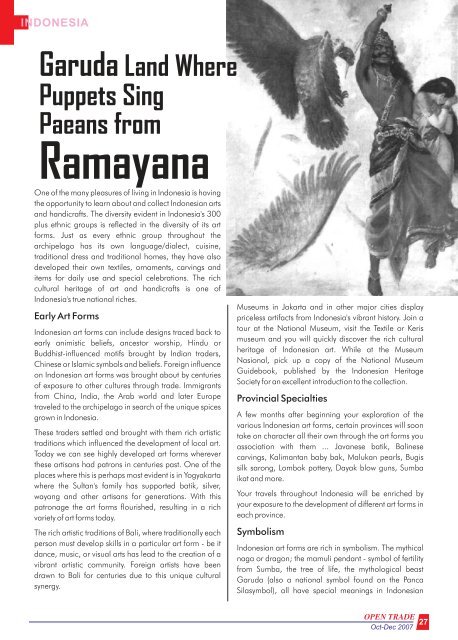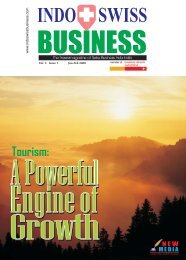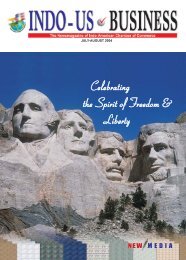pele SciaSction - new media
pele SciaSction - new media
pele SciaSction - new media
You also want an ePaper? Increase the reach of your titles
YUMPU automatically turns print PDFs into web optimized ePapers that Google loves.
INDONESIA<br />
Garuda Land Where<br />
Puppets Sing<br />
Paeans from<br />
Ramayana<br />
One of the many pleasures of living in Indonesia is having<br />
the opportunity to learn about and collect Indonesian arts<br />
and handicrafts. The diversity evident in Indonesia's 300<br />
plus ethnic groups is reflected in the diversity of its art<br />
forms. Just as every ethnic group throughout the<br />
archipelago has its own language/dialect, cuisine,<br />
traditional dress and traditional homes, they have also<br />
developed their own textiles, ornaments, carvings and<br />
items for daily use and special celebrations. The rich<br />
cultural heritage of art and handicrafts is one of<br />
Indonesia's true national riches.<br />
Early Art Forms<br />
Indonesian art forms can include designs traced back to<br />
early animistic beliefs, ancestor worship, Hindu or<br />
Buddhist-influenced motifs brought by Indian traders,<br />
Chinese or Islamic symbols and beliefs. Foreign influence<br />
on Indonesian art forms was brought about by centuries<br />
of exposure to other cultures through trade. Immigrants<br />
from China, India, the Arab world and later Europe<br />
traveled to the archipelago in search of the unique spices<br />
grown in Indonesia.<br />
These traders settled and brought with them rich artistic<br />
traditions which influenced the development of local art.<br />
Today we can see highly developed art forms wherever<br />
these artisans had patrons in centuries past. One of the<br />
places where this is perhaps most evident is in Yogyakarta<br />
where the Sultan's family has supported batik, silver,<br />
wayang and other artisans for generations. With this<br />
patronage the art forms flourished, resulting in a rich<br />
variety of art forms today.<br />
The rich artistic traditions of Bali, where traditionally each<br />
person must develop skills in a particular art form - be it<br />
dance, music, or visual arts has lead to the creation of a<br />
vibrant artistic community. Foreign artists have been<br />
drawn to Bali for centuries due to this unique cultural<br />
synergy.<br />
Museums in Jakarta and in other major cities display<br />
priceless artifacts from Indonesia's vibrant history. Join a<br />
tour at the National Museum, visit the Textile or Keris<br />
museum and you will quickly discover the rich cultural<br />
heritage of Indonesian art. While at the Museum<br />
Nasional, pick up a copy of the National Museum<br />
Guidebook, published by the Indonesian Heritage<br />
Society for an excellent introduction to the collection.<br />
Provincial Specialties<br />
A few months after beginning your exploration of the<br />
various Indonesian art forms, certain provinces will soon<br />
take on character all their own through the art forms you<br />
association with them ... Javanese batik, Balinese<br />
carvings, Kalimantan baby bak, Malukan pearls, Bugis<br />
silk sarong, Lombok pottery, Dayak blow guns, Sumba<br />
ikat and more.<br />
Your travels throughout Indonesia will be enriched by<br />
your exposure to the development of different art forms in<br />
each province.<br />
Symbolism<br />
Indonesian art forms are rich in symbolism. The mythical<br />
naga or dragon; the mamuli pendant - symbol of fertility<br />
from Sumba, the tree of life, the mythological beast<br />
Garuda (also a national symbol found on the Panca<br />
Silasymbol), all have special meanings in Indonesian<br />
OPEN TRADE 27<br />
Oct-Dec 2007

















